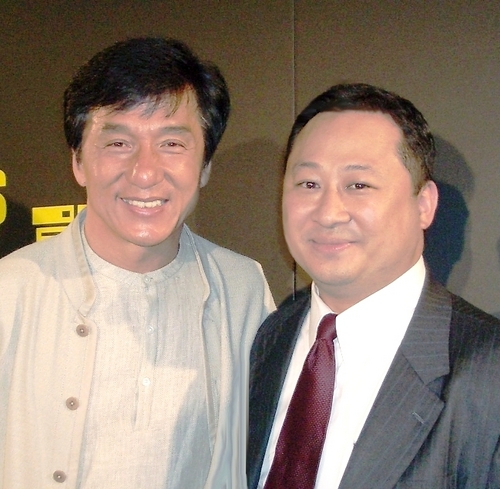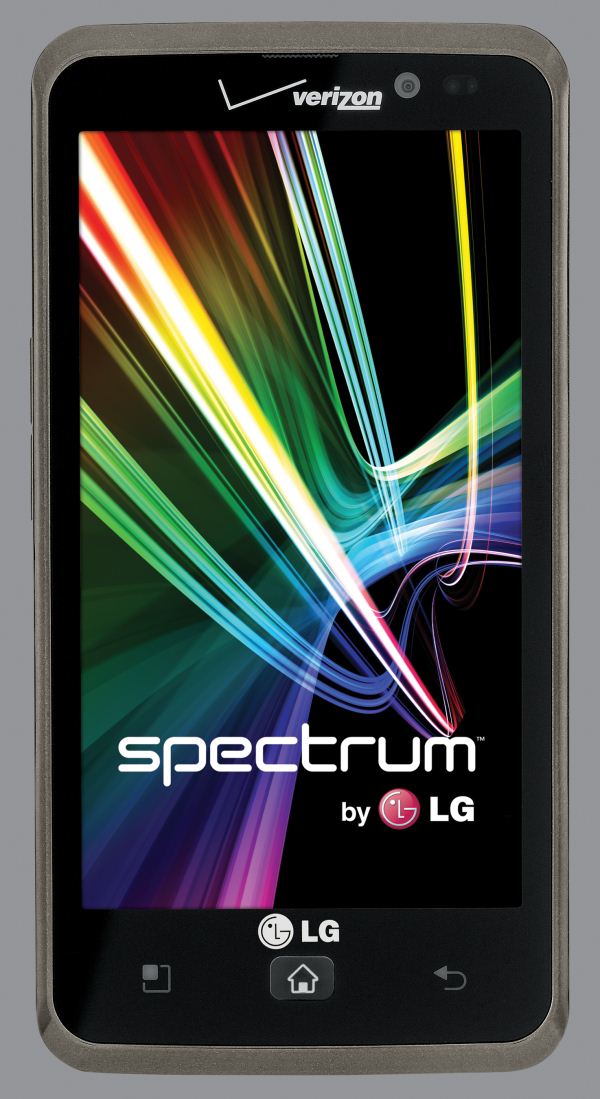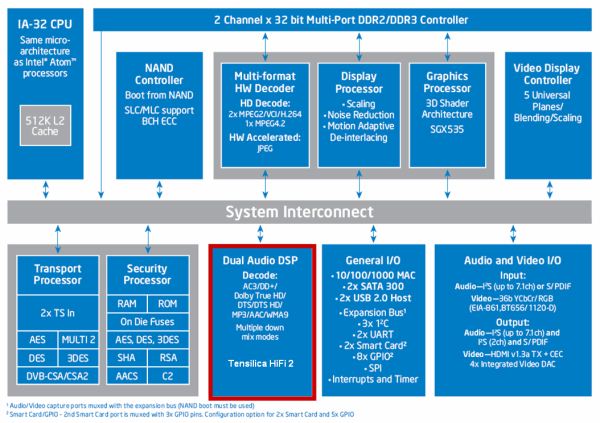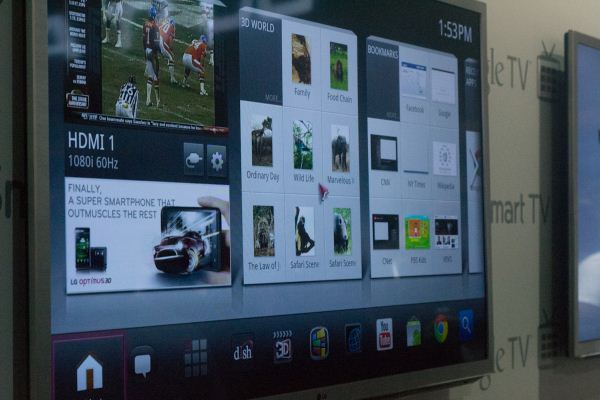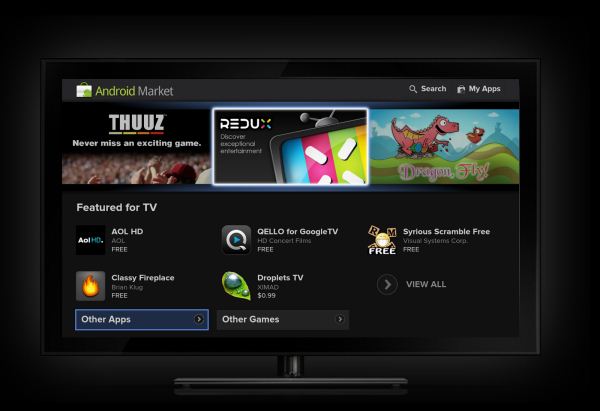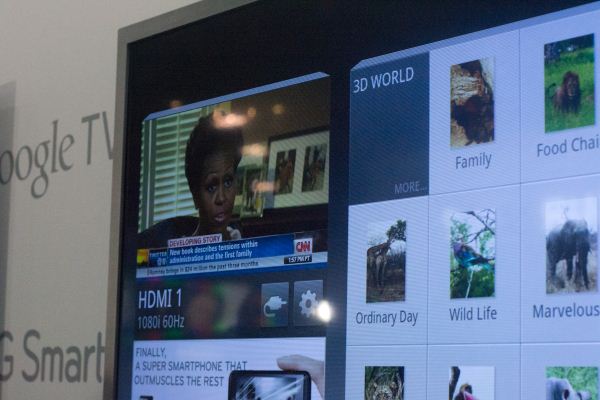
Original Link: https://www.anandtech.com/show/5429/lgs-g6-series-a-new-kind-of-google-tv-partnership
LG's G6 Series: A New Kind of Google TV Partnership
by Jason Inofuentes on February 6, 2012 10:43 PM ESTA common feature in some of the world's most succesful companies is an evangelist. Sometimes that person will be a founder or CEO, other times it will be a salesman or marketing and public relations person. Whatever their role, the evangelist will be passionate about the company, their goals and their products, and if you encounter them, they won't rest until you are as passionate. For LG Electronics, the chief evangelist is a man by the name of Ken Hong.
Ken Hong (Right), with Jackie Chan (Left)
Like many of the Korean technology companies, LG Electronics sits beneath a parent company whose holdings include component makers for their various end consumer products. The synergy opportunities and cost savings of producing your own displays, ICs, software and other components can’t be undersold. And R&D wins translate not just into component sales, but end unit sales. So as a display division develops an innovative screen technology, that success goes into the next handset or television console.
Component R&D requires extensive resources (pronounced money), untold numbers of man hours and a certain amount of time. Generally, throw more money or man hours at something and you’ll need less time to reach a solution. That R&D is just part of the solution. And watching Ken Hong at work, you realize the R&D guys have it easy.
When I met with Ken, officially LG's Global Communications Director, for a tour of the LG Electronics booth at CES, I expected him to be courteous and show me some of the highlights. I expected him to offer talking points and to stray not far off the script. I expected answers to some questions, and a polite “No comment,” to other questions. What I got was an hour long, frank and in depth discussion about LG Electronic’s road map for 2012 and beyond, and a close look at a truly surprising collaboration.
The Year That Was
In 2011, LG had three marquee phones come to market in the US, the LG G2X, LG Thrill 4G and LG Revolution. Each phone was a first for LG: the G2X was the first dual-core phone, the Revolution was their first LTE phone and the Thrill 4G was the first 3D phone with both a 3D display and camera. Developing, announcing, producing and shipping three halo phones in one year is a massive undertaking. And it may have been too much.
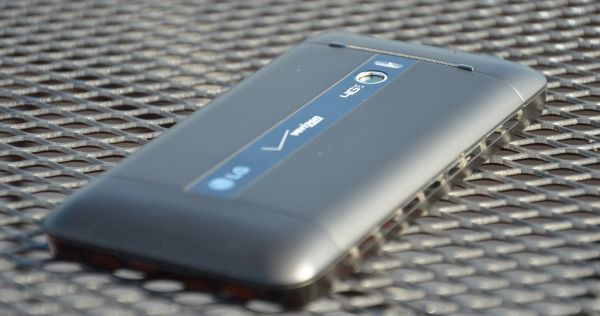
Despite surviving the massive undertaking and having three impressive devices to show for it, neither of those phones is on the tips of everyones tongues. Indeed, when you look back on the year only a few phones stand out in what was a terribly crowded release schedule. And none of those phones is an LG.
Yet despite not having the mindshare penetration they might have hoped for, LG has kept hard at work, improving their released products through software updates, and preparing new devices for release. Late last year they released the LG Optimus LTE, featuring an HD IPS display and an iPhone baiting pixel density. It was rebranded the Nitro HD for AT&T and released as one of their first LTE phones; and was announced on Verizon ahead of CES as the LG Spectrum.
So, maybe not the mindshare they hoped for, maybe not the marketshare they hoped for, but that’s hardly slowed them down.
The Elephant
Whenever we engage a representative of a company, there’s a tendency to avoid mentioning their direct competitors by name. Most often, it’s out of courtesy; they know who their competition is, they don't need us to phrase every question as “Company X did it this way, what will you do?” LG’s competition is local. Samsung is one of the most vertical companies in the world, and they leverage that into marketing across the entire spectrum of consumer electronics. LG’s coverage of that same spectrum is nearly as exhaustive, but they’re not quite as vertical as their competition, and not nearly so large.
With Samsung’s size, they can throw more resources at their projects, which means lower time to market. LG’s R&D goals, then, must focus on creating better solutions and targeting markets that Samsung isn’t. And, where necessary, expand their business to include areas in which Samsung already has a lead.
LG L9
Ken was very excited to show us the G6 Series, a Smart TV line that combines their own UI and apps with Google TV 2.0. He excitedly cornered the product team members that were demonstrating the interface and stood by as I was walked through the features of the new set. When I was done he pulled me close and said excitedly, “That’s our chip inside, that’s the L9.”
Late last April, chip designer ARM put out a press release announcing that LG had licensed some of their IP for use in SoCs. If you check the ARM news site, you’ll see several such releases over the years with lots of different partners. The LG move seemed strategically sound; skipping the middleman and having the SoC specifications you want built by a fabricator could yield cost savings and tighter control. Nothing more was heard about the initiative until CES, when LG revealed it would be powering many members of their Smart TV line.
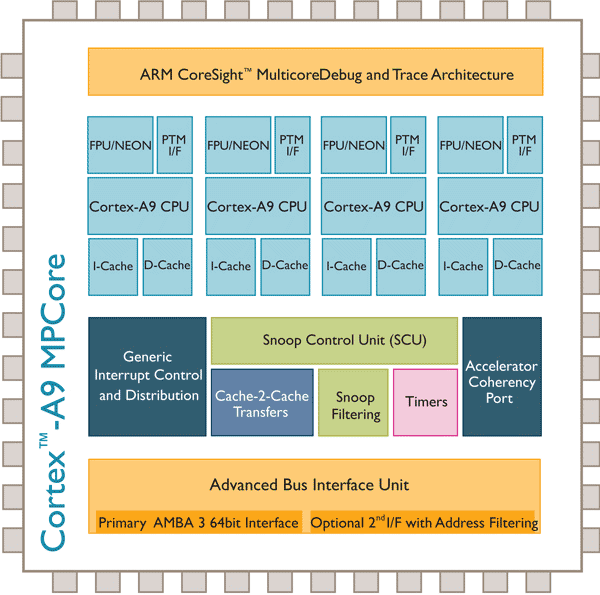
Looking back at that press release could reveal some clues as to what’s included in the LG L9. It describes the licensing agreement as comprehensive and while it specifies access to the Cortex-A9, Cortex-A15 and Mali-T604 designs, it does not do so in a way that would not presuppose access to other designs. Indeed, the release describes the license as covering the Mali family of GPUs. LG expects devices with the L9 to ship during the first half of 2012. Having been described as a dual-core design with a quad-core GPU would make the L9 most likely an ARM Cortex-A9 with a Mali-400 GPU. Such a combination is rather familiar, but also rather competitive, particular with regards to the GPU. From our prior coverage of SoC’s found in media streamers we know that these are generally more lightweight and focused on decoding and displaying video data. Traditionally streaming devices and smart TVs relied on lightweight UIs and functionality limited to just a handful of functions beyond media playback. Even the Roku 2, with its smooth UI and gaming abilities uses a relatively meager SoC compared to the LG L9.
At the time that the original Google TV hardware was released, the use of Intel’s CE4100 seemed a strange platform choice. Intel is fond of selling their products at high margins, a tendency that the consumer and enterprise PC markets support. Generally, SoC markets are CE markets, and only at the high-end do they tolerate high margins. The CE4100’s power profile also made it an unexpected choices. ARM based decoder ICs meant for the Blu-ray market have even started migrating to powerful Cortex-A9 class processors, so it was just a matter of time before Google TV moved on to an ARM based platform such as the ARMADA 1500 and the Mediatek Blu-ray SoCs, and now, the LG L9. Granted that, when the Logitech Revue hit the market, the notion of playing back HD video from a smartphone seemed a futuristic concept. But since then, powerful low power GPUs have provided the differentiation within the mobile space. Many of today’s mobile platforms provide excellent media playback, while also powering complicated UI elements at high resolutions. So it makes sense that the devices that power our TVs should be at least as powerful as our phones.
LG Smart TV with Google TV
LG has set its sales goals impressively high for their Smart TV platform. By their estimates, 60% of their TV sales should be Smart TVs. Achieving this goal will mean targeting a mainstream price point, though we’re not likely to see Smart TV sets below the 40” class. Most Smart TV UI’s are based around Java and HTML5, and developers have typically been required to work within a particular manufacturers SDK in order to get an app released on their platform. Recently, LG joined Philips and Sharp in an initiative to develop a joint SDK based on HTML5, CE-HTML and HbbTV. Ideally, after a successful joint SDK is released, app availability across the three platforms would reach parity with a unified storefront. This sort of partnership was always going to be a necessity before developers would seriously consider smart TV’s a platform to focus on. Other manufacturers remain resolute in keeping their platforms and SDK closed off. Companies don’t like sharing the spotlight, so collaborating on something that they could otherwise brand and promote all to themselves is anathema to some. Everyone wants to be the next Kleenex.
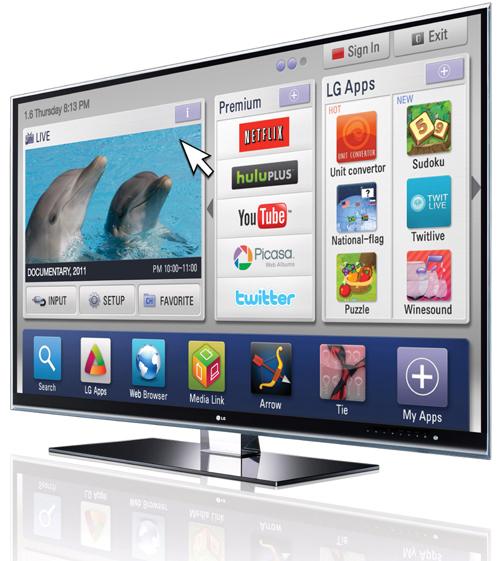
LG’s Smart TV offering is attractive, and straightforward. The home screen features three columns, with the left most featuring a panel displaying the currently playing content. Spread across the rest of the home screen icons for installed apps and services. The center column is reserved for premium apps such as Netflix and Hulu+. The right column will include other installed apps, including games. Across the bottom is a dock with several core apps with room for user selected apps. Controlling the UI is done through something similar to an air mouse solution. It’s referred to as motion controls, but it retains the point and click paradigm familiar to all; the intuitiveness of the solution depends on the accuracy with which the remote’s position reflects the cursor’s position.
When I first heard that LG would not simply be producing a Google TV but instead be marrying their own Smart TV solution with Google TV, I was trepidatious. Google TV’s first iteration involved their own UI layered atop the output of your set-top box, and often the result was having two UIs colliding onscreen, obstructing their own utility and the content being viewed. Worse than this, I worried that the LG Smart TV UI and Google TV would be walled off from each other. That if a user wanted to play an LG optimized version of Angry Birds they would have to exit their Google TV session and effectively reboot into LG’s garden. So, when I caught sight of the television itself I was quite surprised.
LG and Google TV
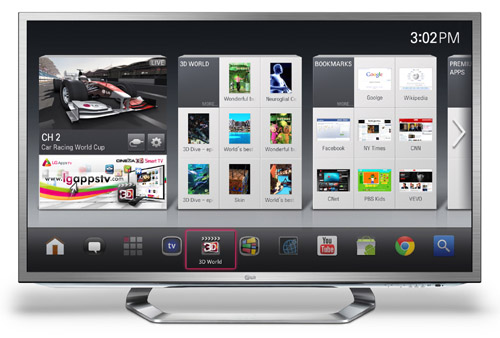
The new interface retains the three column format we saw in the earlier designs, though there’s a higher density of shown content. The content panel is smaller, making room for advertising space in the area below it. The middle column remains reserved for featured content, though the content will be targeted based on your device, so on this 3D set, the features were 3D tech demos. The third panel is now labeled Bookmarks, and to this section the user can pin nearly anything, from stored content and apps, to websites and stations. New panels populate additional screens with the left most screen always serving as the primary home screen. Those panels could include a Recent Apps panel, Settings, and perhaps widgets featuring live updated content. The arrangement seems very familiar to any Android user that’s spent time organizing their home screens.
All this is simple enough, and the density is good, not too overwhelming and not cluttered or busy looking. The dock across the bottom compliments the whole experience well, with a size premium provided to icons within the dock. And along the right side of the dock you find the core Google TV apps: Chrome, YouTube, Search and Market. We were lucky enough to have one of the product managers handle our demonstration and his passion for the product was clear. He gestured excitedly at the new icons and how well they coexisted with the icons and UI from LG.
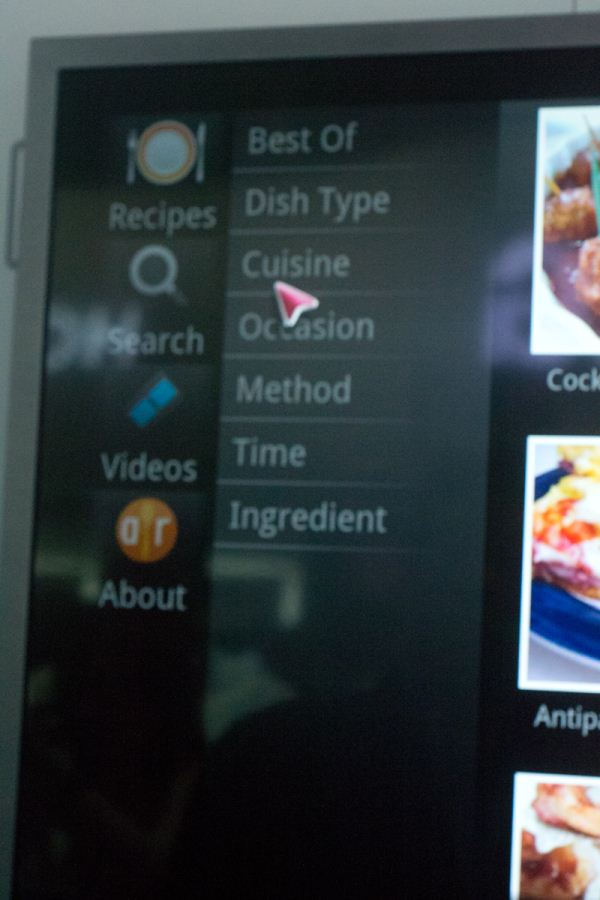
The AllRecipes.com App on LG's Smart TV with Google TV
Surely, I thought, once he clicks on one of those apps, I’ll be greeted by a splash screen and a long delay, as Google TV launches, and then within that instance the Chrome app is opened, or the Market loads. And then it happened, a simple rectangular box, with light grey text, and a font I recognized from the tablet in my bag. The product manager, apologized and reminded me that this was very early software, shipped only days before from their labs in Korea, while scrambling to clear the notification informing us that a background service had stopped responding. That’s when I realized that I wasn’t looking at two OSes set side by side. LG’s Smart TV UI was now an Android 3.2 skin. Google had let them skin Google TV.
The number of Google TV 1.0 products can be counted on one hand, and you’d hardly use all five fingers. Logitech’s Revue was the most successful, and it was a financial disaster for Logitech. Sony produced a television and a Blu-ray Player with the technology built-in. At CES Google introduced several partners in the space including new internal hardware from Marvell and MediaTek, and new product partners in Vizio and LG. The number of products that make it to market will remain relatively small, and will face competition from the myriad OTT solutions that have grown both in number and sales. They’ll also face competition from the likes of Lenovo, who is aggressively repurposing Android 4.0 for their first venture into the TV market, the Lenovo K91. Like all the other K pre-fix denotes a Chinese market product, and few if any of these products make it to US shores. Lenovo’s success in the Chinese TV market could drive efforts to expand globally, though; and beyond that there’s the ever present issue of Google certification.
Google’s Android Market is the value add that they use to leverage control over device manufacturers. As was reported in some legal documents that came to light last year, Google may have acted to block Samsung from releasing certain products because of GPS software implementations. There’s speculation about Google playing favorite’s with some manufacturer’s and stifling down market competition. And all this is muddled when you see that some devices that blatantly break with the speculative standards Google sets for products are granted access to the Market. Recently, in a blogpost on their development portal, Google laid out a new requirement for Market access. Going forward from Android 4.0, device manufacturer’s would be required to build their skins within the Theme framework Google provides, and that at all times, access to the default Holo theme would be retained. While this would still allow for OEM and carrier defined widgets and software preloads, the user would have access to the default core UI. This is something we have been asking for since the Droid Incredible review introduced us to HTC’s Sense UI on Android.
But with Google’s history of having a seemingly arbitrary approval process, it’s difficult to say for sure whether this is more of a soft standard. In business, the rules are simply the starting point for negotiations. Lenovo’s Android 4.0 based solution is purported to have Market access. In a chance encounter with a Lenovo product manager, I was left with the impression that Google had set alternate standards for devices marketed outside of the US. This seems plausible but opens up worries of fragmentations in software. Imagine if an OEM developed a software solution bundled within their skin that had earnest appeal to the end user, an advanced browser for instance. That manufacturer could use this bundling to negotiate access to the Android Market in the US without exposing the Holo theme.
LG wanted to be a Google TV partner. They wanted to have access to the Marketplace, but they wanted to be able to apply their own UI themes. And they were able to negotiate that for Google TV 2.0. What could this mean for later Google TV iterations? We don’t know. As a technology partner, success amongst manufacturer’s is about differentiation. Success amongst consumers is about a consistent user experience. If a mainstream consumer has to relearn how to change channels or access a favorite app, every time they encounter a different television, they will grow frustrated and that will hurt smart TV adoption.
Throughout the rest of the demo there were hiccups, UI stuttering and additional Force Close notifications. Content playback was smooth and the few apps that loaded showed promise. YouTube as a feature on smart TV and OTT solutions carriers a lot of weight, but poses an interesting complication. The vast majority of YouTube content is below standard definition in quality. When stretched across screens larger than a laptop the deficits are ever more pronounced. As HD cameras become more and more ubiquitous (thanks in large part to smartphone adoption), user generated content will improve, but even some professional content can look unpleasant due to compression artifact and poor production quality. Google’s solution seems to be elevating YouTube from a portal for almost entirely user generated content and bringing media partners to provide content. And tying access to this media content through the Android Market could be the leverage Google needs.
Wrap-up
Android skins have been an issue, but generally well accepted by the public. Where confusion strikes is when a user buys an Android device from a competitor, and the e-mail widget is different or the keyboard less friendly. Would the same hold true for a TV? If the core experience (seeking, selecting and viewing content) remained consistent, would users mind a tweaked UI? Google has a long way in proving themselves capable of altering the way we watch televison for the better. Partnering with a manufacturer to make that software experience better may be a good step.

